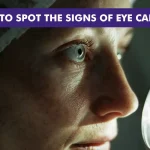A corneal ulcer or keratitis is a serious condition that affects the cornea, the clear outer layer of the eye. It is characterized by an open sore on the cornea, which can lead to vision loss if not properly treated. Corneal ulcers can be caused by various factors, including infections, injuries, and underlying health conditions. In this blog post, we will explore the causes, and symptoms of corneal ulcers, and available treatment options.
If you suspect that you have a corneal ulcer, it is important to seek medical attention as soon as possible. Early diagnosis and appropriate corneal ulcer treatment can help prevent complications and preserve your vision.
What Is Corneal Ulcer (Keratitis)?
To understand what is corneal ulcer, it is helpful to know a bit about the anatomy of the eye. The cornea is the clear, dome-shaped surface that covers the front of the eye. It plays a crucial role in focusing light onto the retina, allowing us to see clearly. When the cornea becomes damaged or infected, it can lead to the development of a corneal ulcer.
Corneal ulcers can be caused by a variety of factors, including bacterial, viral, or fungal infections. They can also occur as a result of trauma to the eye, such as a scratch or foreign object getting lodged in the eye. People with certain underlying health conditions, such as dry eye syndrome or autoimmune disorders, may be more prone to developing keratitis.
Different Causes of Corneal Ulcer
Corneal ulcers can be caused by various factors, including:
- Infections: Bacterial, viral, or fungal infections can invade the cornea and lead to the development of an ulcer.
- Trauma: Scratches, cuts, or foreign objects in the eye can cause corneal ulcers.
- Underlying health conditions: Certain health conditions, such as dry eye syndrome, autoimmune disorders, or diabetes, can increase the risk of keratitis.
- Contact lens wear: Improper use or poor hygiene when wearing contact lenses can increase the risk of corneal ulcers.
It is important to identify and address the underlying cause of a corneal ulcer to ensure effective corneal ulcer treatment and prevent future ulcers.
Symptoms of Corneal Ulcers
Symptoms of corneal ulcer include:
- Eye pain or discomfort
- Redness and inflammation of the eye
- Sensitivity to light
- Excessive tearing
- Blurred vision
- The feeling of something in the eye
If you experience any of these symptoms of corneal ulcers, it is important to see an eye care professional for a proper diagnosis and treatment.
Stages of Corneal Ulcer
Corneal ulcers can progress through different stages, which may affect treatment options and outcomes. The four stages of a corneal ulcer are:
1. Epithelial defect: The outermost layer of the cornea, called the epithelium, is compromised, leading to an open sore.
2. Stromal infiltration: The infection or inflammation spreads to the deeper layers of the cornea, causing opacity and possible vision loss.
3. Descemetocele: The ulcer progresses even deeper, reaching the innermost layer of the cornea, called the Descemet’s membrane.
4. Corneal perforation: The ulcer becomes so severe that it perforates the cornea, causing severe pain and potential loss of the eye.
Early detection and prompt corneal ulcer treatment are essential to prevent the ulcer from progressing to more advanced stages.
How Is Corneal Ulcer Diagnosis Done?
Diagnosing a corneal ulcer typically involves a comprehensive eye examination. The eye care professional may perform the following tests:
- Visual acuity test to assess your vision
- Slit-lamp examination to examine the cornea under high magnification
- Fluorescein staining to highlight any defects or ulcers on the cornea
- Cultures or swabs to identify the specific cause of the infection, if present
Based on the diagnosis, the eye care professional can determine the appropriate treatment approach.
Treatment of Corneal Ulcers
The corneal ulcers treatment depends on the underlying cause and the severity of the ulcer. Common options include:
- Antibiotic or antifungal eye drops to treat the infection
- Steroid eye drops to reduce inflammation and promote healing but they must not be given till the infarction is under control
- Lubricating eye drops or ointments to relieve symptoms and prevent dryness
- Oral medications in severe cases or when the infection is not responding to topical treatments
- Treat underlying diseases like diabetes
- Advanced cases may need a corneal transplant to replace the infected tissues with healthy tissue.
It is important to follow the prescribed treatment plan and attend follow-up appointments to monitor the progress of the ulcer.
Prevention and Care Tips for Corneal Health
To maintain good corneal health and reduce the risk of keratitis, consider the following tips:
- Practice good hygiene when handling and wearing contact lenses
- Avoid wearing contact lenses while swimming or in environments where they may come into contact with contaminants
- Use proper eye protection when participating in sports or activities that may pose a risk of eye injury
- Avoid rubbing or touching your eyes with dirty hands
- Follow good eye care practices, such as regular eye exams and using prescribed eye drops or medications as directed
By taking these preventive measures, you can help protect your cornea and reduce the risk of developing eye ulcers.
Conclusion
Corneal ulcers are a serious eye condition that can lead to vision loss if not promptly diagnosed and treated. It is important to be aware of the common causes and symptoms of corneal ulcers and seek medical attention if you suspect you have one. With early intervention and appropriate treatment, most eye ulcers can be effectively managed, minimizing the risk of complications.
If you have any concerns about your eye health or suspect you may have a corneal ulcer, consult an eye care professional for an accurate diagnosis and personalized treatment plan.
FAQs
What is the main cause of corneal ulcer?
Corneal ulcers can be caused by various factors, including infections (bacterial, viral, or fungal), trauma to the eye, underlying health conditions, and improper contact lens use.
What is the cure for corneal ulcer?
This is a placeholder tab content. It is important to have the necessary information in the block, but at this stage, it is just a placeholder to help you visualise how the content is displayed. Feel free to edit this with your actual content.
Do corneal ulcers go away?
With proper treatment, most corneal ulcers can heal within a few weeks. However, the healing time may vary depending on the severity of the ulcer and the individual’s response to treatment.
Will corneal ulceration go away?
Corneal ulceration can go away with appropriate treatment and care. However, it is important to seek medical attention for proper diagnosis and treatment, as untreated corneal ulcers can lead to complications and vision loss.
Is a corneal ulcer a medical emergency?
Corneal ulcers require prompt medical attention, but they may be considered a medical emergency. You must visit an eye doctor within a day and avoid self medication.
What are the four stages of a corneal ulcer?
The four stages of a corneal ulcer are epithelial defect, stromal infiltration, Descemetocele, and corneal perforation. Early detection and treatment are crucial to prevent the ulcer from progressing to more severe stages.




